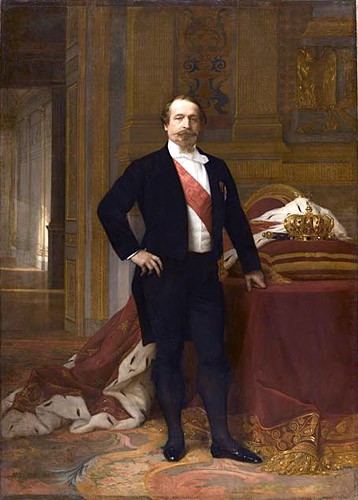Originally from Montpellier, Alexandre Cabanel’s career was without blemish, beginning, in the most classic of fashions, with a schooling according to the 19th century academic curriculum. This was followed by the Prix de Rome in 1845 and medals at the Salon of 1853 and the Universal Exhibition of 1855. That same year, he was made a chevalier (knight) of the Légion d’honneur. In 1863, a particularly busy year, he was elected to the Institute, made professor at the Ecole des Beaux-Arts, and promoted to the rank of officier (officer) of the Légion d’honneur. He also benefitted more directly from the imperial couple’s favour: it was the French emperor who purchased Cabanel’s Nymph and Satyr as well as, at the 1863 Salon, his famous Birth of Venus. Both of these works were subsequently hung in the imperial palaces. Between 1861 and 1868, thanks to his status as “official painter”, the artist was also invited on numerous occasions to the “séries” (less formal imperial court gatherings) held at Compiègne.
At the 1865 Salon, Cabanel exposed a standing portrait of Napoleon III; on this occasion, he actually asked for an extension of one month, claiming that the paint was still wet! This request was addressed to the Comte de Nieuwerkerke, and was founded on a quite irrefutable argument: his painting’s subject. “I would not have dared such bold behaviour were I not certain that my work will, by its very subject matter, most likely protect you, in your responsibility, from all recrimination”, he noted. The composition depicts the emperor posing in the Tuileries Palace, dressed in his dark evening wear, and wearing the sash of the Légion d’honneur, visible across his chest. One hand is placed on his right hip, whilst the other rests on the table, upon which lie the symbols of sovereign power: the ermine cloak, the hand of justice and the crown. In both its intimacy and its urbanity, this representation of Napoleon III was entirely unlike his other official portraits, in which he poses in his military dress, produced by Winterhalter and Flandrin. The work was greatly admired by those within the imperial couple’s close circle, and was eventually obtained for 20,000 Francs – taken from the Salon acquisitions budget – following decrees issued on 27 August and 12 October, 1866. Cabanel’s painting ended up replacing Flandrin’s work in the empress’s study at the Tuileries Palace. Critical reaction, however, was far less kind and the intense rivalry between the two paintings by Flandrin and Cabanel was cause for much amusement in the art world. Cabanel’s composition, largely ridiculed in workshops, was accorded the nickname “a maître d’hôtel’s portrait”!
Cabanel’s portrait of Napoleon III was given to the Empress Eugénie after the fall of the empire and for a period occupied pride of place in her study in Farnborough. In 2008 it was added to the Château de Compiègne’s collections and, following a quite remarkable restoration project and the construction of a frame – only recently completed – it has now returned on display.
Karine Huguenaud (tr. H.D.W.)
September 2010


